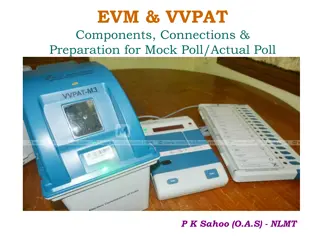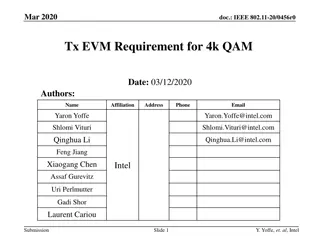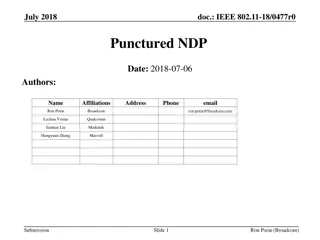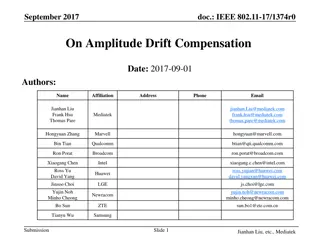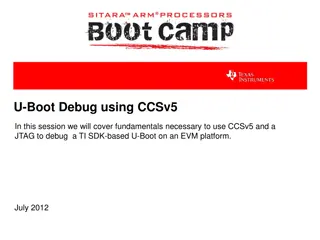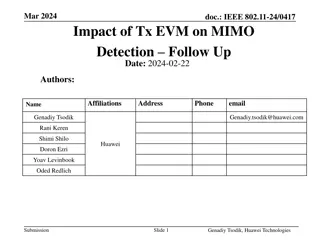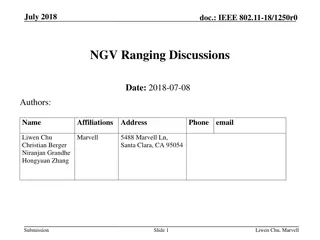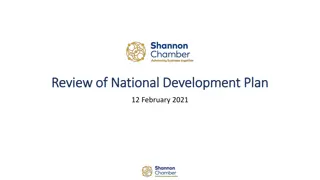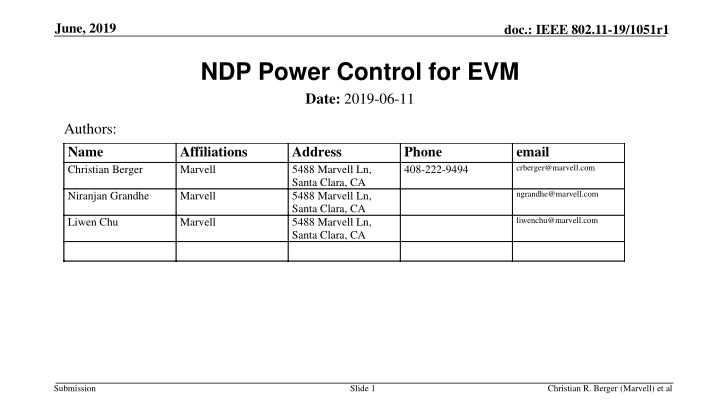
Power Control and EVM in Wireless Communications
Explore the trade-off between transmission power and Error Vector Magnitude (EVM) in wireless communication, notably in WiFi OFDM systems. Learn about the impact of optimizing power levels on signal quality and how to adjust power for effective communication. Discover the significance of acknowledgments (ACK) and channel sounding packets in achieving optimal power control.
Download Presentation

Please find below an Image/Link to download the presentation.
The content on the website is provided AS IS for your information and personal use only. It may not be sold, licensed, or shared on other websites without obtaining consent from the author. If you encounter any issues during the download, it is possible that the publisher has removed the file from their server.
You are allowed to download the files provided on this website for personal or commercial use, subject to the condition that they are used lawfully. All files are the property of their respective owners.
The content on the website is provided AS IS for your information and personal use only. It may not be sold, licensed, or shared on other websites without obtaining consent from the author.
E N D
Presentation Transcript
June, 2019 doc.: IEEE 802.11-19/1051r1 NDP Power Control for EVM Date: 2019-06-11 Authors: Name Christian Berger Affiliations Marvell Address 5488 Marvell Ln, Santa Clara, CA 5488 Marvell Ln, Santa Clara, CA 5488 Marvell Ln, Santa Clara, CA Phone 408-222-9494 email crberger@marvell.com ngrandhe@marvell.com Niranjan Grandhe Marvell liwenchu@marvell.com Liwen Chu Marvell Submission Slide 1 Christian R. Berger (Marvell) et al
June, 2019 doc.: IEEE 802.11-19/1051r1 Need for Power Control Trade-off between Tx power and Tx EVM In any wireless communication Especially OFDM in WiFi, has large peak-to-average power ratio (PAPR) Needs power amplifier to back off more (so peaks avoid non-linear region) Maximizing Tx power usually reduces signal quality Typically sacrifice back-off Power amplifier will go (more often) into non-linear region Tx signal distortion is measured as Error Vector Magnitude (EVM) Typical range -10 to -30 dB WiFi s 11ax has increased EVM range (1024 QAM, MU-MIMO, etc) Submission Slide 2 Christian R. Berger (Marvell) et al
June, 2019 doc.: IEEE 802.11-19/1051r1 Typical Approach Based on ACK Most WiFi Packets are acknowledged If no ACK is received, packet was most likely lost Typically due to insufficient SINR at receiver to decode packet Required SINR to decode a packet depends on the Modulation and Coding Scheme (MCS) used Definition of receiver sensitivity maps required SINR for each MCS Given required SINR Maximize Tx power Keeping EVM below required SINR (reduces SINR by at most 3 dB) If packet is lost, drop MCS (assumes SINR is fixed) and adjust Tx power Submission Slide 3 Christian R. Berger (Marvell) et al
June, 2019 doc.: IEEE 802.11-19/1051r1 EVM on Channel Sounding Packets Channel Sounding In WiFi uses Null Data Packets (NDP) No data in packet, no frame check sequence (FCS) There is no correct reception of NDP SNR will gradually change quality of channel estimates (no cut-off) To set Tx power and EVM correctly, transmitter needs to know the pathloss or get some other feedback (to replace the ACK) Estimate pathloss Receiver can measure RSSI, but needs to know Tx power Submission Slide 4 Christian R. Berger (Marvell) et al
June, 2019 doc.: IEEE 802.11-19/1051r1 Effect of EVM on SINR Effective Signal-to-Interference+Noise Ratio (SINR) Received power (Tx power minus path loss ?PL) EVM is part of the interference (?EVM) Other interference and receiver thermal noise ?Tx?PL SNR = ?0+?EVM?PL?Tx For example at ?Tx= 0 dBm ?PL= 60 dB ?0= 90 dBm ?EVM= 20 dB SNR = 19.6 dB (dominated by Tx EVM) Submission Slide 5 Christian R. Berger (Marvell) et al
June, 2019 doc.: IEEE 802.11-19/1051r1 Optimize EVM in Non-TB Ranging Each STA transmits one data packet and one NDP Best to measure RSSI of NDP packets Pathloss is symmetric (assume tx/rx antenna gain symmetric) Data packets could either include RSSI (of some previous NDP) Tx power level of NDP Measurement Sounding part Measurement Reporting part NDP-A UL NDP Initiator SIFS SIFS SIFS DL NDP LMR Responder Submission Slide 6 Christian R. Berger (Marvell) et al
June, 2019 doc.: IEEE 802.11-19/1051r1 Step 1: Measure Pathloss To optimize EVM/Tx Power Need to know pathloss Suggestion Tx Power in NDP-A RSSI in LMR Send Tx Power NDP-A UL NDP Initiator SIFS SIFS SIFS DL NDP LMR Send RSSI feedback Responder Submission Slide 7 Christian R. Berger (Marvell) et al
June, 2019 doc.: IEEE 802.11-19/1051r1 Step 2: Adjust Tx Power and EVM There is an inherent tradeoff ?Tx?PL max SNR ?Tx = ?0+?EVM?Tx?PL?Tx ?0 ?0 min ?PL?Tx+ ?EVM?Tx min max Suggested algorithm Measure pathloss ?PL Adjust ?Tx to make ?EVM similar to ?PL?Tx,?EVM?Tx ?0 ?PL?Tx Needs ?0 constant Related to receiver sensitivity Can also just use as desired EVM floor Submission Slide 8 Christian R. Berger (Marvell) et al
June, 2019 doc.: IEEE 802.11-19/1051r1 Details and Example Example Assume Tx Power was 0 dBm Reported RSSI was -70 dBm ?0 is 90 dBm (configured in negotiation) EVM at current Tx Power is -20 dB ?0 ?PL?Tx= 20 dB Submission Slide 9 Christian R. Berger (Marvell) et al
June, 2019 doc.: IEEE 802.11-19/1051r1 Alternative Step 2 Complications Receiver might not want to reveal ?0 Desired EVM could be more complicated relationship EVM not straight forward to define/measure on NDP Feedback desired EVM in LMR/NDP-A as virtual MCS STA s don t know other STA s ?EVM?Tx Assume monotonic around current ?Tx 11ax defines EVM for each MCS Simply request EVM based on PTx Submission Slide 10 Christian R. Berger (Marvell) et al
June, 2019 doc.: IEEE 802.11-19/1051r1 Proposal: Enable Measurement Add Tx power in NDP-A Reuse format of trigger frame AP Tx Power subfield is 6 bit, mapping values of 0:60 to - 20:40 dBm; would have to add an extra STA Info 32 bit, similar to SAC B0 B10 B11 B16 B17 B26 B27 B28 B31 RSVD AID11 Tx Power RSVD Disambiguation RSVD Bits: 11 6 10 1 4 Alternatively can use 6 bit used for Offset in secure TB Ranging STA Info Field B0 B10 B11 B16 B17 B19 B20 B22 B23 B25 B26 B27 B28 B30 B31 AID11/ RID11 Tx Power / Offset Disambiguati on DL N_STS DL Rep UL N_STS Reserved UL Rep Reserved Bits: 11 6 3 3 3 1 1 3 1 Submission Slide 11 Christian R. Berger (Marvell) et al
June, 2019 doc.: IEEE 802.11-19/1051r1 Proposal (cont.) Add RSSI in LMR 7 bits (0:127) Map to 0:-1:-127 dBm RSSI Public Action Dialog Token ToD Error ToA Error Category ToD ToA RSSI Octets: 1 1 1 6 6 1 1 1 Secure LTF Parameter (optional) AoA CFO Alternatives Add Tx Power Add pathloss (Tx Power RSSI) Feedback (optional) Parameter Octets: 2 13 9 Submission Slide 12 Christian R. Berger (Marvell) et al
June, 2019 doc.: IEEE 802.11-19/1051r1 How to Set EVM at Tx Side Tx side can control EVM Maps Tx Power to EVM Some dependence on modulation used How to optimize SINR? Tx side does not know receiver noise figure Related to receiver sensitivity Option 1: Transmitter decides best EVM Option 2: Receiver shares N0 in negotiation Option 3: Receiver proposes an EVM setting using Virtual MCS Virtual MCS specifies that, an NDP is transmitted with the same transmit power and the same transmit configuration parameters as the ones the device would use to transmit a data packet at the MCS rate that is equal to the Virtual MCS rate, in order to meet the corresponding EVM requirement defined in Table 27-49 of 802.11ax D4.2. Submission Slide 13 Christian R. Berger (Marvell) et al
June, 2019 doc.: IEEE 802.11-19/1051r1 Proposal: Set EVM Let each STA select desired EVM based on virtual MCS Feed back virtual MCS (values 0-11) The application could be delayed or immediate B0 B10 B11 B16 B17 B20 B21 B26 B27 B28 B31 Equiv. MCS RSVD AID11 Tx Power RSVD Disambiguation RSVD Bits: 11 6 4 6 1 4 Add similar field in LMR Submission Slide 14 Christian R. Berger (Marvell) et al
June, 2019 doc.: IEEE 802.11-19/1051r1 Proposal (cont.) Alternatively, use 2 reserved bits in STA Info Format can be compressed based on pathloss 4 values can be spread out, e.g., MCS 1-4-7-10 4 values are mapped to MCS [0:3]+MCSoffset (e.g., based on 11ax Table 27-51 Receiver minimum input level sensitivity) Pathloss < -70, MCSoffset=0, MCS 0-3 -70 < Pathloss < -60, MCSoffset=1, MCS 1-4 -60 < Pathloss < -50, MCSoffset=2, MCS 2-5 B0 B10 B11 B16 B17 B19 B20 B22 B23 B25 B26 B27 B28 B30 B31 AID11/ RID11 Tx Power / Offset Equiv. MCS Bit0 Equiv. MCS Bit1 Disambiguati on DL N_STS DL Rep UL N_STS UL Rep 11 6 3 3 3 1 1 3 1 Submission Slide 15 Christian R. Berger (Marvell) et al
June, 2019 doc.: IEEE 802.11-19/1051r1 Strawpoll I Do you support to add subfields in Ranging NPD-A and LMR to facilitate tx- power and EVM optimization in Non-TB Ranging? Yes: No: Abstain: Submission Slide 16 Christian R. Berger (Marvell) et al
June, 2019 doc.: IEEE 802.11-19/1051r1 Strawpoll II Do you support to add the AP Tx Power subfield in the Ranging NPD-A as presented in Option Option I (Extra Field): B0 B10 B11 B16 B17 B26 B27 B28 B31 RSVD AID11 Tx Power RSVD Disambiguation RSVD Bits: 11 6 10 1 4 Option II (Reuse Offset): STA Info Field B0 B10 B11 B16 B17 B19 B20 B22 B23 B25 B26 B27 B28 B30 B31 AID11/ RID11 Tx Power / Offset Disambiguati on DL N_STS DL Rep UL N_STS Reserved UL Rep Reserved Bits: 11 6 3 3 3 1 1 3 1 I: II : Abstain: Submission Slide 17 Christian R. Berger (Marvell) et al
June, 2019 doc.: IEEE 802.11-19/1051r1 Strawpoll III Do you support to add the following field in the LMR frame from non-TB Ranging Option I: AP Tx Power Option II: RSSI Option III: Pathloss I: II : III: Abstain: Submission Slide 18 Christian R. Berger (Marvell) et al
June, 2019 doc.: IEEE 802.11-19/1051r1 Straw poll IV Do you support to add the Requested Virtual MCS in the NDPA frame and the Transmitted Virtual MCS in the R2I LMR frame for non-TB Ranging per slide 14? Yes: No: Abstain: Submission Slide 19 Christian R. Berger (Marvell) et al



